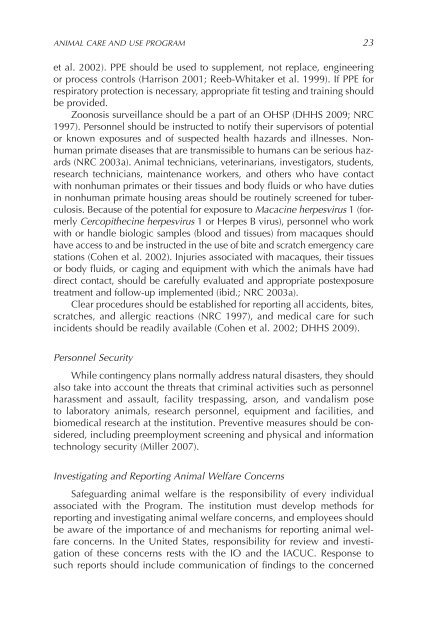Guide for the Care and Use of Laboratory Animals - Office of ...
Guide for the Care and Use of Laboratory Animals - Office of ...
Guide for the Care and Use of Laboratory Animals - Office of ...
- No tags were found...
You also want an ePaper? Increase the reach of your titles
YUMPU automatically turns print PDFs into web optimized ePapers that Google loves.
ANIMAL CARE ANd USE PROGRAM 23et al. 2002). PPE should be used to supplement, not replace, engineeringor process controls (Harrison 2001; Reeb-Whitaker et al. 1999). If PPE <strong>for</strong>respiratory protection is necessary, appropriate fit testing <strong>and</strong> training shouldbe provided.Zoonosis surveillance should be a part <strong>of</strong> an OHSP (DHHS 2009; NRC1997). Personnel should be instructed to notify <strong>the</strong>ir supervisors <strong>of</strong> potentialor known exposures <strong>and</strong> <strong>of</strong> suspected health hazards <strong>and</strong> illnesses. Nonhumanprimate diseases that are transmissible to humans can be serious hazards(NRC 2003a). Animal technicians, veterinarians, investigators, students,research technicians, maintenance workers, <strong>and</strong> o<strong>the</strong>rs who have contactwith nonhuman primates or <strong>the</strong>ir tissues <strong>and</strong> body fluids or who have dutiesin nonhuman primate housing areas should be routinely screened <strong>for</strong> tuberculosis.Because <strong>of</strong> <strong>the</strong> potential <strong>for</strong> exposure to Macacine herpesirus 1 (<strong>for</strong>merlyCercopi<strong>the</strong>cine herpesirus 1 or Herpes B virus), personnel who workwith or h<strong>and</strong>le biologic samples (blood <strong>and</strong> tissues) from macaques shouldhave access to <strong>and</strong> be instructed in <strong>the</strong> use <strong>of</strong> bite <strong>and</strong> scratch emergency carestations (Cohen et al. 2002). Injuries associated with macaques, <strong>the</strong>ir tissuesor body fluids, or caging <strong>and</strong> equipment with which <strong>the</strong> animals have haddirect contact, should be carefully evaluated <strong>and</strong> appropriate postexposuretreatment <strong>and</strong> follow-up implemented (ibid.; NRC 2003a).Clear procedures should be established <strong>for</strong> reporting all accidents, bites,scratches, <strong>and</strong> allergic reactions (NRC 1997), <strong>and</strong> medical care <strong>for</strong> suchincidents should be readily available (Cohen et al. 2002; DHHS 2009).Personnel SecurityWhile contingency plans normally address natural disasters, <strong>the</strong>y shouldalso take into account <strong>the</strong> threats that criminal activities such as personnelharassment <strong>and</strong> assault, facility trespassing, arson, <strong>and</strong> v<strong>and</strong>alism poseto laboratory animals, research personnel, equipment <strong>and</strong> facilities, <strong>and</strong>biomedical research at <strong>the</strong> institution. Preventive measures should be considered,including preemployment screening <strong>and</strong> physical <strong>and</strong> in<strong>for</strong>mationtechnology security (Miller 2007).Inestigating <strong>and</strong> Reporting Animal Welfare ConcernsSafeguarding animal welfare is <strong>the</strong> responsibility <strong>of</strong> every individualassociated with <strong>the</strong> Program. The institution must develop methods <strong>for</strong>reporting <strong>and</strong> investigating animal welfare concerns, <strong>and</strong> employees shouldbe aware <strong>of</strong> <strong>the</strong> importance <strong>of</strong> <strong>and</strong> mechanisms <strong>for</strong> reporting animal welfareconcerns. In <strong>the</strong> United States, responsibility <strong>for</strong> review <strong>and</strong> investigation<strong>of</strong> <strong>the</strong>se concerns rests with <strong>the</strong> IO <strong>and</strong> <strong>the</strong> IACUC. Response tosuch reports should include communication <strong>of</strong> findings to <strong>the</strong> concerned
















